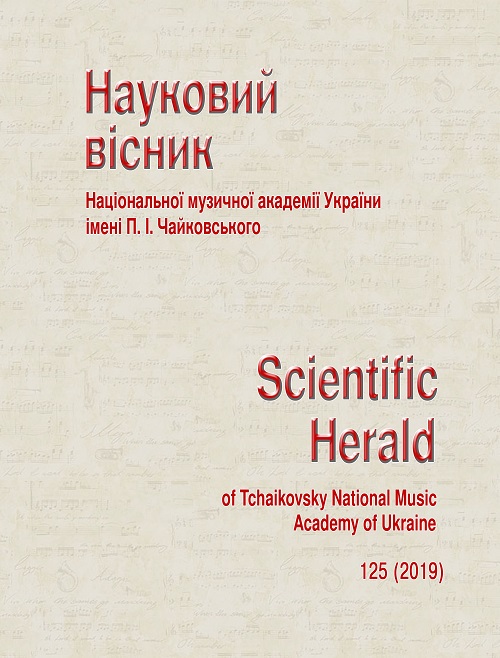The Formation of Anna Korsun’s Individual Style in the Sound Space of Vocal Creativity
DOI:
https://doi.org/10.31318/2522-4190.2019.126.197974Keywords:
individual style, A. Korsun’s vocal creativity, sound, timbre, experimentAbstract
Relevance of the study. Studying of individual composer styles allows learning musical art in its individual, unique manifestations. It is also a necessary component in studying of styles of more general levels. The study of the music of young talented composers, one of which is the Ukrainian-German composer A. Korsun, ensures the inclusion of Ukrainian musicology in the most advanced processes of contemporary national and world music culture.
The lack of scientific research on vocal music by A. Korsun defines the scientific novelty of this article, which deals with all so far existing vocal pieces of the composer. The main objective of the study is to identify the features of A. Korsun's individual style and the process of their formation in the sound space of vocal creativity.
The following methods form a methodology of this article: analytical — to reveal sound features of vocal music by A. Korsun; comparative — for comparison of common and distinctive features in composer's vocal works; chronological — to consider the forming of methods of working with sound consistently from the first to the last vocal piece; historical — for inclusion of A. Korsun’s vocal creativity in the general historical and cultural musical context.
Results. A versatile work with sound is one of the main factors in the organization of vocal works by A. Korsun. It includes active engagement of noise sounds, non-traditional sound production techniques, coloristic interpretations of verbal text, modification or addition to a human voice by additional tools, experimentation with stereo effects, sound illusions, «mobile» sound by using space possibilities in placing the performers, and their movement while singing. The performers basis is the non-academic manner of singing with the superiority of soft sound not in the full voice and the manner of croon (the term by A. Korsun) in fragments with a closed mouth that means humming, singing without trying to do it clear.
Conclusions include the marking of the significance of the timbre in the formation of the dramaturgy in vocal scores by A. Korsun, its influence on the feeling of tempo and rhythm. The presence of the most important individual-style elements of composer’s music is noted already in the first vocal works. Overcoming the limits of performance elitism and the availability of Korsun’s works for non-professional musical performers are specified. Beyond-national nature of the composer’s vocal creativity and its orientation to the contemporary world music practice are accented. The significance of results of the study is the possibility to use them in courses of the history of contemporary Ukrainian and world music, composition, history and theory of vocal performance.
Downloads
References
Morozova, L. (2013). Composers change their occupation [Kompozitory menyayut professiyu]. Kommersant Ukraine [Kommersant Ukraina]. No. 18, p. 4. [In Russian].
Sharina, А. V. (2018). Expanded techniques in music for piano solo by composers of the Kiev school (on an example of using glissando in “Aqua sonare” by A. Korsun and Sonata No. 3 “Aer” by B. Zanko) [Rozshyreni tekhniky v muzytsi dlia fortepiano solo kompozytoriv kyivskoi shkoly (na prykladi vykorystannia glissando v «Aqua sonare» A. Korsun ta Sonaty No. 3 «Aer» B. Zanka], master’s work. National Music academy of Ukraine of P. Tchaikovsky; supervisor I. H. Tukova. Kyiv. 73 с. [In Ukrainian].
Eggert, M. (2017). A panegyric to clear scores and puzzling music [Eine Lobrede auf klare Partituren und rätselhafte Musik]. New music newspaper [Neue Musikzeitung]. December (No. 66). Available at: https://www.nmz.de/artikel/eine-lobrede-auf-klare-partituren-und-raetselhafte-musik?fbclid=IwAR0yzwG7ibBE7RP83I6mv_JN_w4VKfF3omHKbnG6ywCUE0GeIbnjuAPhlJk. [In German]. [Accessed 17.05.2019].
Giotz, T. (2018). Anna Korsum composes in Sondershausen with voice and keyboard [Anna Korsum komponiert in Sondershausen mit Stimme und Tastatur]. Thüringer Allgemeine. 17 Juli. Available at: https://www.thueringer-allgemeine.de/web/zgt/suche/detail/-/specific/Anna-Korsum-komponiert-in-Sondershausen-mit-Stimme-und-Tastatur-2143948721?fbclid=IwAR14R0moEqG9ofENunJcg7XOss_uzzmB55UbmxFqtVL1LXyJkqUPqhoc0BI [Accessed 23.05.2019]. [In German].
Janssen, T. (2018). Think and interpret yourself [Selbst denken und deuten]. Elbe-Jeetzel-newspaper [Elbe-Jeetzel-Zeitung]. 21 February, p. 5. [In German].
Kautz, M. (2016). Carefully hearing traps! Portrait of the Ukrainian composer Anna Korsun [Vorsicht Hör-Fallen! Porträt der ukrainischen Komponistin Anna Korsun]. MusikTexte. Magazine for new music [MusikTexte. Zeitschrift für neue Musik]. No. 150, pp. 6–11. [In German].
Kleinteich, N. (2016). Saalfeld: tango and symphony in a successful symbiosis [Saalfeld: Tango und Sinfonie in erfolgreicher Symbiose]. East Thuringian newspaper [Ostthüringer Zeitung]. 05 Dezember. Available at: http://saalfeld.otz.de/web/saalfeld/startseite/detail/-/specific/Saalfeld-Tango-und-Sinfonie-in-erfolgreicher-Symbiose-984838883. [Accessed 20.05.2019]. [In German].
Tchiba, M. (2015). Born of silence (the music of the Ukrainian composer Anna Korsun) [Aus Stille geboren (die Musik der ukrainischen Komponistin Anna Korsun)]. New music magazine [Neue Zeitschrift für Musik]. No. 3, pp. 59–61 [In German].
Vehn ter, J. (2017). Concert for dredger, blower, chainsaws and tampers [Konzert für Absetzer, Laubbläser, Kettensäge und Rüttelstampfer]. Leipzig folk newspaper [Leipziger Volkszeitung]. Available at: http://www.lvz.de/Region/Markkleeberg/Konzert-fuer-Absetzer-Laubblaeser-Kettensaege-und-Ruettelstampfer [Accessed 24.05.2019]. [In German].
Wüst, M. (2012). «Tohuwabohu» in Schwere Reiter. Running through the networks in a woolen web space reflects on unrecognizable chaos [«Tohuwabohu» im Schwere Reiter. Netzflüchter im Wollfadenweb reflektieren über nicht erkennbares Chaos]. Available at: http://www.kulturvollzug.de/article-26241/2012/03/11/tohuwabohu-im-schwere-reiter-netzfluchter-im-wollfadenweb-reflektieren-uber-ein-nicht-erkennbares-chaos/ [Accessed 24.05.2019]. [In German].
Downloads
Published
How to Cite
Issue
Section
License
Our journal abides by the CREATIVE COMMONS copyright rights and permissions for open access journals.
Authors, who are published in this journal, agree to the following conditions:
The authors reserve the right to authorship of the work and pass the first publication right of this work to the journal under the terms of a Creative Commons Attribution License, which allows others to freely distribute the published research with the obligatory reference to the authors of the original work and the first publication of the work in this journal.
The authors have the right to conclude separate supplement agreements that relate to non-exclusive work distribution in the form in which it has been published by the journal (for example, to upload the work to the online storage of the journal or publish it as part of a monograph), provided that the reference to the first publication of the work in this journal is included.




